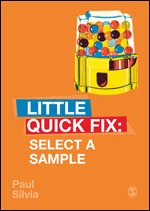Select a Sample
Availability :
In Stock
₹ 653.67
M.R.P.:₹ 807
You
Save: ₹153.33 (19.00% OFF)
(Inclusive
of all taxes)
Delivery:
₹ 0.00 Delivery charge
Author:
Paul Silvia
Publisher:
SAGE Publications Ltd
Edition:
1st Edition
ISBN-13:
9781529708998
Publishing Year:
January 2021
No. of Pages:
128
Weight:
140 grm
Language:
English
Book Binding:
Paperback











